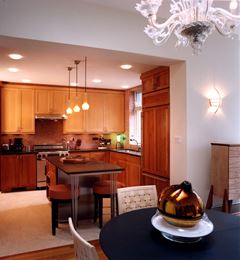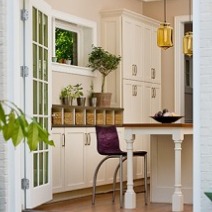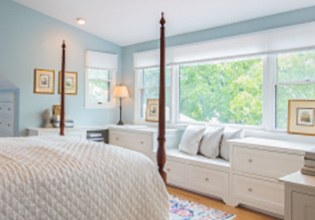The Evolving Dining Room
The American dining room continues to evolve as our lifestyles become more informal and the walls come down between our kitchens and adjacent living spaces. The push and pull of the dining room’s place in a home is becoming more apparent as new homes are built and older homes are remodeled. The march toward open floor plans and informal dining spaces, which are more integrated with the kitchen, continues.
What I Often See
I first became aware of this shift from formal to informal dining rooms in 1986 when I opened my architectural practice and began to see how my clients lived. The size and importance of the dining room has always varied depending upon a homeowner’s socio-economic status. Large homes have the extra seldom-used space for a formal dining room, and they can easily have two dining spaces—one formal and one informal.
For homeowners with smaller homes, it is hard to justify using the space for a formal dining room if it is seldom used. In the past—until the mid-century modern open floor plan began to appear in the 1950s—the dining room was a separate and defined room, separated from the kitchen with walls and often fitted-out with crown molding, chair rail or a wainscot, and a chandelier in the center of the ceiling. This was a formal dining room, used for family meals as well as special occasions. It was definitely not meant to share air space with the kitchen where all activity, as well as cooking odors, were behind closed doors.
These days, I frequently meet with homeowners who want to remodel and open up interior spaces. Many homeowners say, “I never use my dining room and it’s wasted space.” Their goal is to integrate the kitchen with their dining room or adjacent family room. Most homeowners choose to keep their living rooms separate and more formal. If there is a family room, they will definitely want to blend the family room space with the kitchen. If there is no family room, they may decide to build a family room addition. Residential design needs to accommodate homeowners who do most of their living in the kitchen and family room.
How Wentworth Integrates Kitchens & Dining Rooms
Thoughtful design solutions allow us to achieve the goal of integrating the kitchen with the dining room. The age and vintage of a house have a strong influence on the preferred design solution. For older homes built from 1900 – 1950, our designs often open the wall to make a wide cased opening between the kitchen and dining room, or kitchen and family room. The opening might vary from 5 – 12 feet and the molding, trim, and base are replicated to provide a seamless appearance. In older homes, we open the spaces while maintaining visual definition. For example, the ceilings might not be contiguous. Within the new opening, we will often place a kitchen cabinet peninsula or an island that enhances the functionality and communication between the two spaces—open and yet defined.
For homes designed in a mid-century modern style, or mid-century influence, we can be freer in the way we open up the spaces. Ceiling planes might be dropped over the kitchen or island to define spaces. Ceilings and floor materials can be more contiguous and the definition between the kitchen and dining area will be more ambiguous.
Furniture & Multi-Functional Dining Spaces
In addition to opening up the walls between the kitchen and dining room, the way in which we furnish our dining rooms is evolving to make them more functional. Table designs selected can be more flexible. Drop-leaf tables or tables with extension leaves allow for flexibility in size. Often a table will no longer be placed in the middle of the dining room but to one side, which frees up space for circulation and upholstered seating. Upholstered host and hostess chairs with arms will do double-duty for dining and leisure, and they are more comfortable than a straight back dining chair. If the dining room is large enough, it can be furnished with a love seat and a few upholstered lounge chairs, with a dining table off to one side. For homeowners seeking multi-use space, bookcases can be built in the dining room and the dining table can double as a library table.

Lighting is also designed to be more flexible. Tracks attached to the ceiling allow decorative hanging fixtures to be moved about, or minimalistic track lighting can change to suit any dining occasion.
In the end, thoughtful and sensitive design solutions will maximize a home’s space and fit the period or style of the home for a seamless aesthetic.
Contact our DC area architects to learn more about our remodeling services or if you’re ready to integrate your kitchen and dining space!
About Architect Bruce Wentworth
Wentworth was founded by Bruce Wentworth, AIA, a noted remodeling architect who has worked in the Washington, DC, metropolitan area for over twenty years. He has built hundreds of his own designs, ranging from modest bungalows to large-scale luxury residences.
Read the rest of Bruce’s bio.







